By Duane Thomas
Vang Comp Systems, named for its owner Hans Vang, is a company specializing in custom upgrades to the combat shotgun, both pump and semi-auto of various marques, intended to give police officers and hard-core self-defense oriented citizen shooters more efficient weapons. I recently had Vang Comp do up one of their MMC Ghost Ring model custom shotguns for my review. Let’s take a closer look at this gun:
I shipped to Vang Comp a plain Jane, inexpensive Remington 870 Express and they shipped me back an exquisite custom scattergun. As part of the Vang Comp package the 870’s standard wooden furniture has been replaced with a black composite forend and stock fitted with thick rubber recoil pad, both these from Speed Feed, Inc.
The heart of this gun is the Vang Comp Systems (VCS) modification, which both tightens shot patterns and decreases felt recoil. This system consists of back boring the barrel and lengthening the forcing cone. “Back boring” refers to actually opening up the diameter of the bore .002” along its entire length except the last 1-1/4”, which in effect creates a choke to tighten shot patterns, and also make the gun more accurate with slugs.
To understand the concept of lengthening the forcing cone and its advantages, picture a standard cylinder bore barrel which what most “riot guns” have. The forcing cone is the portion of the barrel that transitions from the chamber to the bore of the gun. Think of it as the on-ramp to a freeway. In a standard factory gun the forcing cone is about 1/4” long and very sharply angled. By the time Vang Comp is through with it the forcing cone is 1/1-2 to 2” long, and thus has a far more gradual taper. The number one advantage of this is that when the shot begins to leave the shell it won’t instantly hit the “wall” of a sharply angled forcing cone and deform. Rather the shot is “babied” as it’s guided into the barrel far more gently. Since the shot is not deformed, it flies more accurately, thus you get better patterns over longer distances.
Lengthening the forcing cone also gives you the perception of less felt recoil. In a normal shotgun, almost as soon as the shot begins to move it hits the forcing cone and you instantly get whacked with all that recoil. The lengthened forcing cone extends the recoil impulse out over a longer period of time. That doesn’t really lessen the amount of recoil, it just makes it seem lighter, which makes the gun far more pleasant to fire. Recoil perception is a very subjective thing. My personal take on it, from firing this shotgun both before and after modification: I would say that running Federal Tactical Loads though a VCS’ed 12 gauge feels like firing a stock 20 gauge.
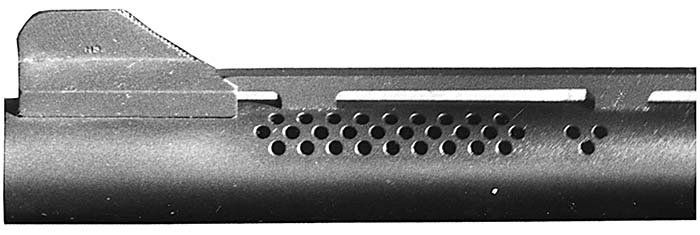
There are two versions of VCS, the Comp and Non-Ported models. Both of these systems feature the same internal modifications to the barrel (back boring, lengthened forcing cone) the only difference being that the Comp model has ports drilled toward the front of the barrel, to vent expanding propellant gases upward and thus hold down muzzle flip during recoil, and the Non-Ported version, naturally, doesn’t. Both systems have their virtues:
The Comp model offers enhanced control of barrel rise during rapid fire. Another positive trait is that the ported barrel has about half the muzzle flash of a standard barrel. You’d expect a ported barrel would vent burning powder gases upward across the line of sight and give you more muzzle flash than a non-ported barrel (that’s certainly what happens on compensated auto pistols) however this data was gathered by Larry Nickols of the Burbank PD and apparently that’s the truth. The porting does make the gun louder, since noise also travels up and back toward you as well as simply out the front of the muzzle and away. Hans Vang reports that about 90 percent of his customers opt for the Comp model VCS.
An advantage to the Non-Ported system would be if an individual or police department didn’t want any outwardly visible modifications to the barrel. And the gun is a bit quieter. Also, if officers were going to do an entry in the “stacking position” with one officer right above the other, it’s possible with a ported gun the guy right above it might get some muzzle gas in the face when the lower man fires.
Sights are from MMC, a high visibility ramp front mated to a fully adjustable ghost ring rear. Says Hans Vang, “As far as I’m concerned, MMC makes the best ghost rings sight available today. I’m of the old school, I like things machined from billeted steel.” These sights feature tritium inserts for low light shooting, consisting of a dot up front and a bar beneath the rear ghost ring aperture.
The 870 Express started out with a simple round barrel. Hans takes a standard Remington 26” or 28” vent rib barrel and cuts it down to 18-1/4 or 18-1/2”, then installed the sights. Combined with the MMC ramp/ghost ring set-up, the vent rib configuration on this gun really looks nice.
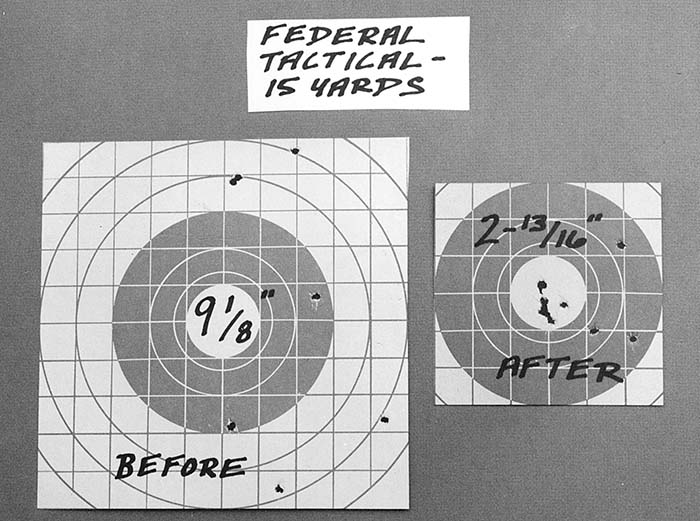
Out-of-the box the gun came with Remington’s “shorty” four-round magazine tube. Fitted with a Scattergun Technologies (SGT) tube extension, mag capacity jumps from four to six 2-3/4” shells, making this a seven-shot gun with one in the chamber. The stock magazine tube follower of black plastic has been replaced with a follower in high visibility day-glo orange, also from SGT; this makes it much easier when inspecting the gun to visually verify the magazine is empty.
The gun has been fitted with an SGT magazine cap with quick detachable sling swivel. The swivel holds the sling off to the left, which could be a very nice thing if you ever wanted to put a tactical light on this gun; with the sling off to the side it won’t get in the way of the light. The sling itself is the Giles Tactical Sling, which is considered by many experts the best tactical sling available. One of the nice things about the Giles sling is that it doesn’t require a sling swivel on the butt, being instead affixed with a Velcro loop. When worn by a right handed operator the “loop” of the Giles sling goes over the right shoulder; when the gun is released the gun simply hangs across the chest, barrel angled downwards. This allows you to have both hands free but not lose instant access to the gun. The Giles unit can also be used as a conventional carry sling.
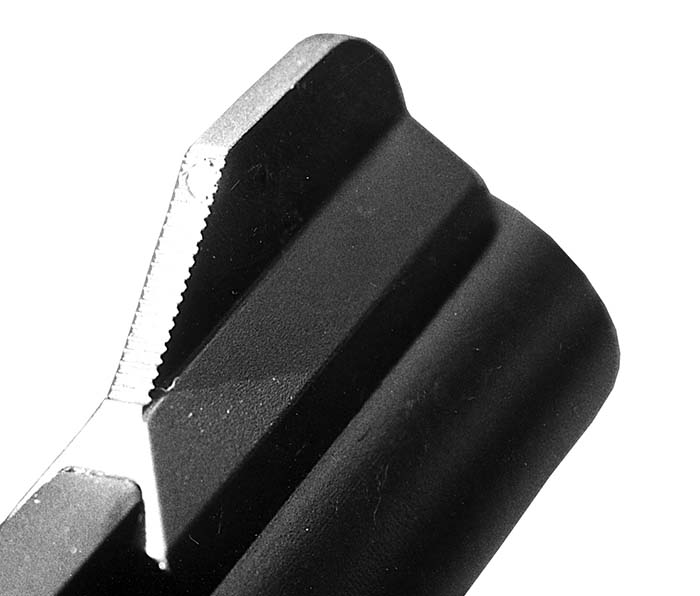
One of the most common upgrades among serious defensively minded shotgunners is finding some way to carry a spare ammo supply that is fixed in an accessible manner to the gun. Probably the best system existing is the side saddle ammo carrier, and one of these is included in the Vang Comp custom package. Mounted on the gun’s right side aft of the ejection port, this unit holds six 12-gauge shells ready to hand.
The Remington 870’s standard small safety button, located on its right side behind the trigger guard, has been upgraded with the installation of a greatly oversized part for more positive manipulation.
Trigger pulls on an out-of-the-box Remington 870 tend to be around 4-1/2 pounds. Vang Comp doesn’t really lighten the trigger pulls, just makes them crisper by very lightly touching up the sear. If the gun needs it, Vang Comp also polishes the slide rails and hones internal parts so the gun cycles very smoothly.
For my testfiring of the Vang Comp Systems custom Remington 870, Hans Vang recommended Federal’s Tactical Load as the best choice. Since this is an extremely popular load for the tactical 12 gauge both among police and serious citizens, limiting my buckshot testing to this load was no great hardship. The Tactical Load carries the familiar nine 00 buckshot pellets traditional in a 2-3/4” 12 gauge shell, but with velocity downloaded from 1,600 to 1,400 feet per second. This is Federal’s approach to giving police and other shooters 12 gauge stopping power with less recoil.
Let’s compare the accuracy of the gun both before and after Vang Comping. We’ll refer to the gun’s performance as BVC (Before Vang Comp) and AVC (AfterVang Comp).
BVC at seven yards the 870 printed a nicely centered 4-1/8” pattern. AVC at the same distance pattern size shrank in half (actually a bit less) to 2”. Lengthening the range to 15 yards, BVC pattern size was a mediocre 9-1/8”.
AVC pattern size again at 15 yards was only marginally larger than at seven yards, a quite impressive 2-13/16”. Perceptive readers will recognize this means the VCS equipped 870 actually printed tighter patterns at 15 yards (2-13/16”) that it had at seven yards (4-1/8”) before being Vang Comped!
When I received the customized shotgun back from Vang Comp, they included a test target fired at 50 feet, marginally farther away than my own 15 yard shooting. On this target were five different patterns fired with the Federal Tactical Load. Average group size hovered right around five inches, a bit more or less, with one superb though anomalous group of 2-3/4”. Also on the target was a three shot group fired from the bench with Brenneke low recoil slugs. All three slugs went into a tight 1-1/8” cloverleaf that bears an amazing resemblance to Mickey Mouse.
Back to my own testing; at 25 yards BVC I wasn’t able to measure pattern size because the gun couldn’t put all nine pellets on paper. AVC it could, albeit barely, in a group of 12”. Hans Vang has commented, “For decades the 12-gauge shotgun has been characterized as being a 15-yard gun, if you want to be safe. With the Vang Comp it’s a 25 yard gun!” Vang Comp Systems literature states, “The VCS modification increases the effective range of the 12 ga. shotgun using 00 Buck to an excess of 50 yards.”
I’m not sure I can buy that. Even at 25 yards, pattern size is loose enough to pose an unacceptably high risk of several pellets from even a well-centered group missing the target and whizzing past to endanger innocent bystanders. This is simply unacceptable in an urban environment. As far as I’m concerned the Vang Comped 870 is still a 15 yard gun…but it’s a far safer 15 yard gun, since compared to a stock weapon its condensed patterns give you a much better chance of keeping all nine 00 buck pellets inside the thorax area. The tighter the pattern, the safer things will be for noncombatants during the gunfight.
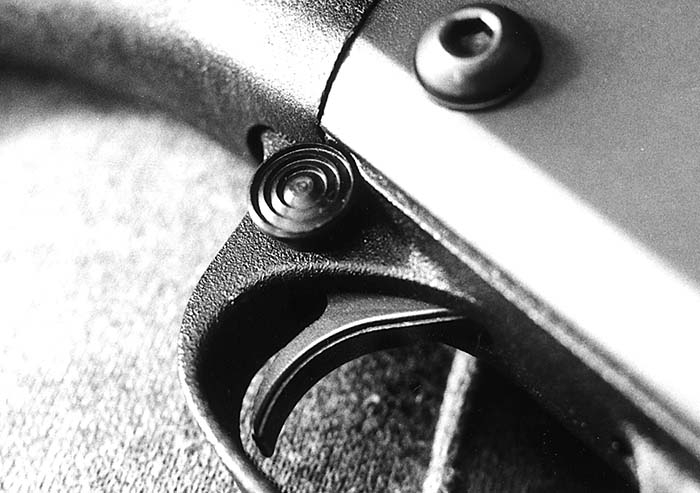
Moving ever to the rear, and switching to slugs as we traveled far, far beyond prudent buckshot range, another target fired by Hans Vang was sent to me along with the gun, this one bench rested from 50 yards. On this target the first two sighting-in shots went low, approximately two inches below the bull’s-eye. After the adjustable ghost rings were fine-tuned, of the five shots fired for record four went into a slightly vertically strung group measuring 2”. The final, fifth shot was alas a flyer opening up overall group size to 4-1/2”. Still, four shots into 2” at 50 yards is not too shabby for a slug loaded 12 gauge!
There were no malfunctions of any kind encountered during my testing of the Vang Comp Systems custom Remington 870, just perfect operation.
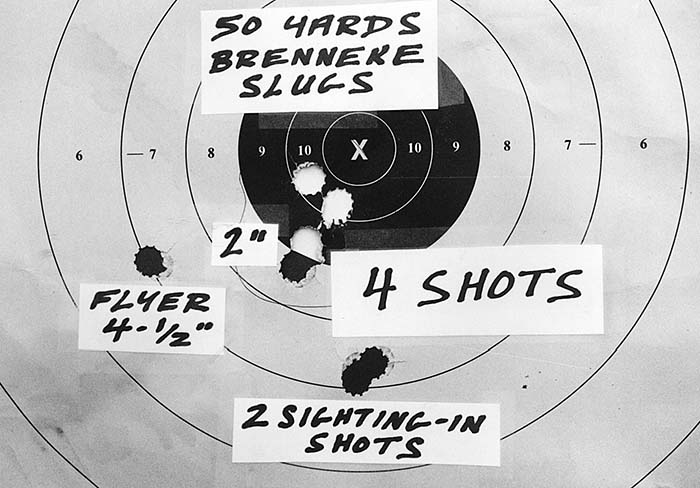
The cost of this weapon from Vang Comp Systems is $815 (plus shipping & handling, of course) and that’s not a “done up on your gun” price but includes the base gun. There are also several other custom packages available from Vang Comp that are less expensive than the one reviewed here. Simply having the VCS modification and nothing else done to your gun costs $195 for a ported barrel and $145 for a non-ported one, and you don’t need to send them the entire gun, only the barrel. For more information you may write to Vang Comp Systems, Dept GAH, 234 Orange Avenue, Goleta, CA 93117 or phone (805)964-7956. The fax number is (805) 964-6467. The web-site address is www.vangcomp.com.
| This article first appeared in Small Arms Review V2N3 (December 1998) |











